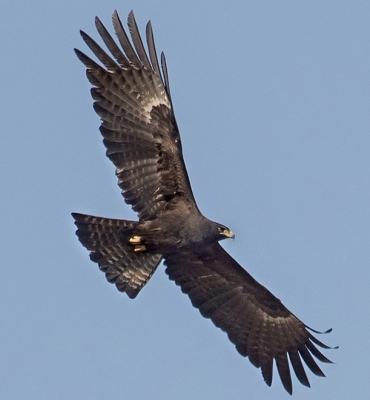
The black eagle (Ictinaetus malaiensis) is a large raptor with an all-black plumage. It has a yellow bill base and feet and a long black tail with faint, white bands. Its wings are broad and long, with distinct fingers or stand-out feathers that give it a slightly ragged look. Its tail is fan-shaped when open and wedge-shaped when closed. Its beak is yellow to gray with a black tip. Its claws are not as curved as some of the other eagles.
Like all eagles, this raptor also falls in the family accipitridae and is the only member of the genus lctinaetus. It is found in most parts of the world and is characterized by its distinctive slow flight. It feeds on mammals such as rats, bats, squirrels, frogs, insects and reptiles. However, its preferred food source is eggs! It has the dubious distinction of being known as a prolific nest predator! It is known to scan the canopy of trees it flies over for unattended nests. Black eagles are also known to forage in pairs and sometimes make off with an entire nest of nestlings to feed upon at a feeding perch.
Their long, extended wing feathers (primaries) may have evolved because of this hunting technique. These feathers help them to fly at slow speeds so they can scan the canopy of trees below for prey. Their gradually curving feet are ideal for carrying off an egg and once they spot a target, they swoop down and grab it in their talons.
Males and females look alike but the young have a light brown head and underparts. This raptor makes its nest high up in the branches of tall trees. Typically the nests are large, around 1.2 m wide and are set in the forks of branches well covered by dense foliage above. Usually a pair will have more than one nest and reuse these, year after year.
Black eagles are listed as a species of ‘least concern’ in the IUCN (International Union for Conservation of Nature) Red List, but face threats from deforestation and loss of prey populations.
Picture Credit : Google




